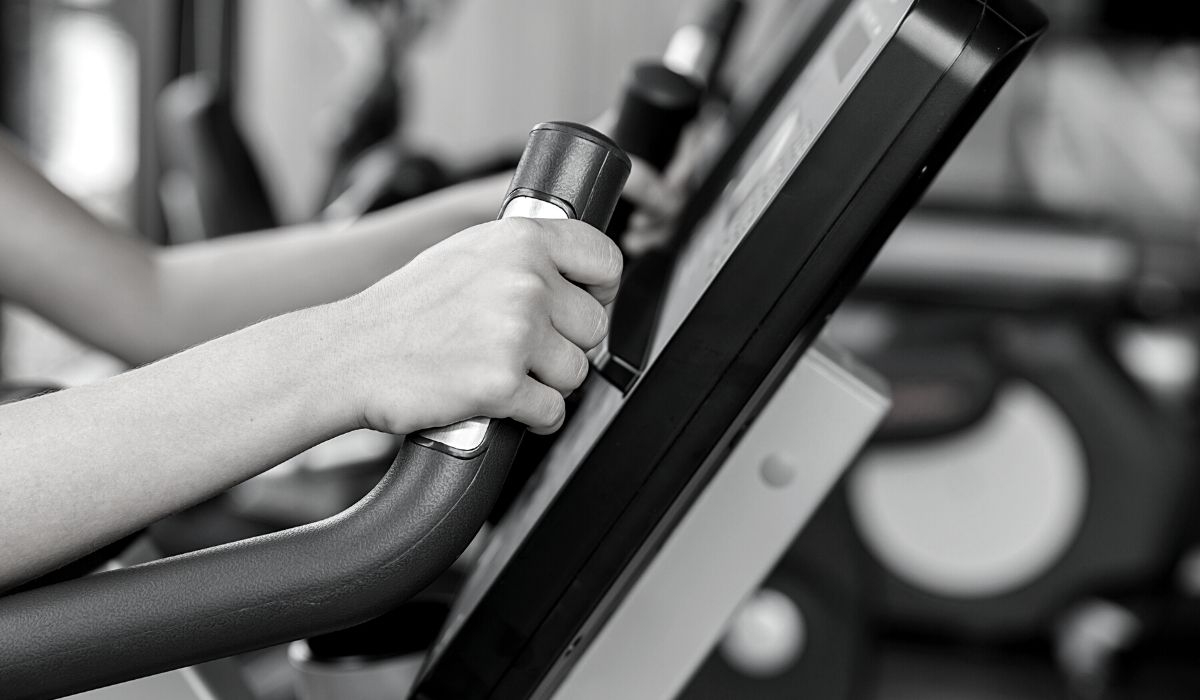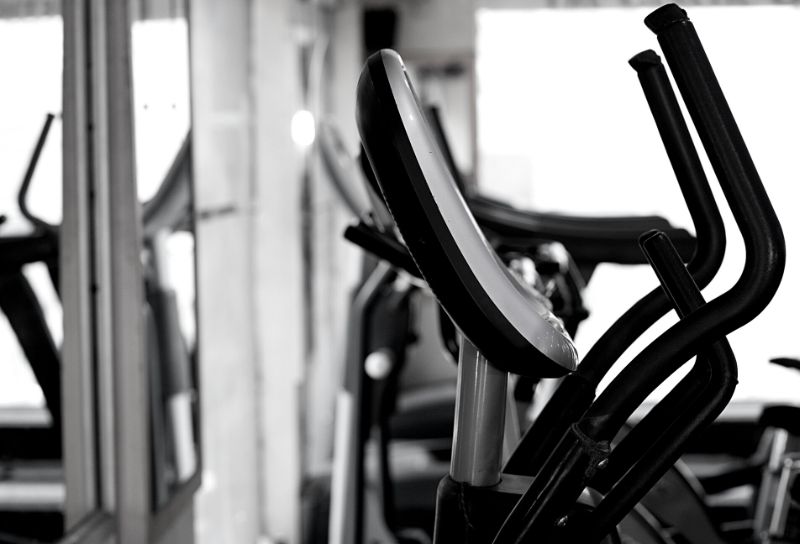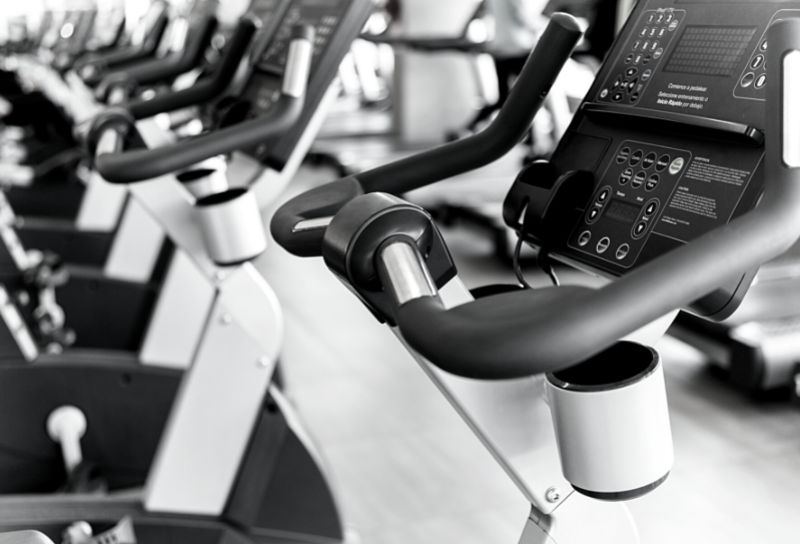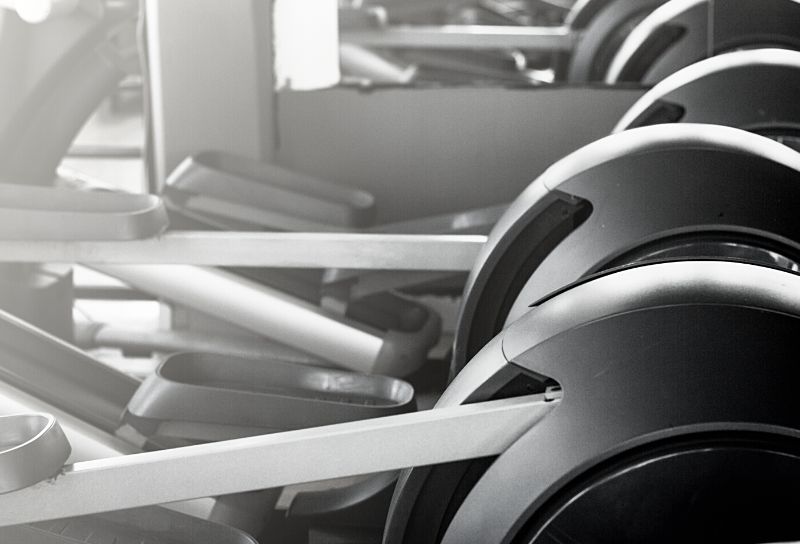Wondering if the elliptical or the stationary bike is going to get you to your workout goals faster? Here’s a detailed look at the pros and cons of each. To the cardio machines!

Cycling and elliptical training are two of the most popular cardio options in the gym.
Both offer a great way to push your cardiovascular endurance hard, strengthen your muscles, and burn a LOT of calories and fat.
But the question is: which is actually better?
Are one of the two workouts more effective than the other—meaning a better use of your time?
Below, we’ll find out!
I’ll walk you through all of the most important factors involved in your workout, and see how both types of exercise match up.
By the end of this post, you’ll have a very clear idea of which of the two cardio workouts is the best choice to include in your regular training sessions.
Elliptical vs Stationary Bike – Calories Burned
There are many complex factors that go into weight loss (such as diet, metabolism, hormones, and more), but at its core, there’s a fairly simple formula you can follow.
That formula is: weight loss = calories burned > calories consumed.
That’s why I always like to start with how many calories any given exercise burns. That way, you can evaluate how effectively you can use it to increase your daily caloric expenditure to match the “ideal” calorie intake.

The more calories a workout burns, essentially the “better” it is for helping you to end the day at the calorie deficit that leads to weight loss.
According to Harvard Medical School1 a 155-pound person will burn 252 calories in 30 minutes of a stationary bike workout at a “moderate” pace. If you up the pace to “vigorous,” you can burn up to 378 calories in that same half-hour.
The power of the stationary bike to burn a lot of calories is fairly apparent. And because you can sit down (i.e. more comfortable for many trainees), you can really crank up the calorie burning on the bike.
However, when we compare that to the calories burned on the elliptical machine, the difference is pretty obvious. In a “general” elliptical machine workout (which seems to translate into a “moderate” workout), that same 155-pound person will burn 324 calories in a half-hour.
When you push the elliptical pace to vigorous, the calorie burning increases even more (though it’s not included on the Harvard Medical School list).
The elliptical machine wins the first round.
Elliptical vs Stationary Bike – Weight Loss
Both the elliptical and stationary bike are popular cardio machines for weight loss because they allow you to burn a lot of calories while still keeping your heart rate in what is called the “Fat Burning Zone”.
This “zone” is really a range—60 to 75% of your Max Heart Rate. The more time you spend working in that zone, the easier your body can activate fat for energy (rather than utilizing the sugar present in your bloodstream and liver).
Because of the way the elliptical works your entire body (see the “Muscles Worked” section below), it’s actually incredibly easy to push yourself above that 75% heart rate.

If you pedal too fast, push the incline too high, or add some extra difficulty into the workout (such as squat-walking), you’ll increase your heart rate above the target and thus end up burning more sugar-based calories than fat.
Cycling, on the other hand, takes more work to push your heart rate up into that fat-burning zone, but once you get it up, it’s fairly easy to keep it there.
In a way, it’s easier to sustain the fat-burning for longer by cycling because it uses less of your body’s total energy than elliptical training.
Elliptical vs Stationary Bike – Cardio
When we talk about “cardio”, we’re talking about your body’s ability to absorb oxygen through the lungs and pump oxygenated blood to the muscles that are being worked.
Your heart has to do the work of pumping and your blood vessels have to dilate in order to allow for increased blood flow. The more these internal functions all work together, the better your cardiovascular endurance and the less prone you’ll be to developing cardiovascular health problems.
Both elliptical training and stationary biking are highly effective at developing cardiovascular endurance.
Because they involve sustained activity in your muscles, they increase the energy demands placed on your body and force your heart and lungs to work to deliver oxygenated blood to the parts of your body that are doing the work.

However, as you’ll see in the “Muscles Worked” section, the elliptical engages far more muscles than stationary cycling. Stationary cycling is entirely for your legs, while elliptical training works your entire body.
What this means is that with elliptical training, your body has to send more blood to more muscles, which increases calorie burning and forces your cardiovascular system to work harder.
Because of how far and wide your heart has to pump blood and how hard your lungs have to work to absorb oxygen, elliptical training is marginally better for your cardiovascular conditioning overall.
Elliptical vs Stationary Bike – Functional Fitness
If you read my elliptical vs running article, you know I’m a HUGE proponent of functional fitness—“fitness that supports and improves your activities of daily life”.
This is one area where the elliptical machine often comes in second place to other cardio machines. For example, on the treadmill, you’re training to run, which you do every time you go for a jog, take your pet to the park, play with your kids, etc.
Compare that to the elliptical, which is a movement that’s not quite walking, not quite running, and not quite cycling. It’s not as “practical” as other types of exercise.
With the stationary bike, you’re training the leg muscles that you’ll use every time you hop on a bike to go for a ride. Spending more time training on the stationary bike will translate into more effective cycling in real life, which, ultimately, makes it a more “functional” form of exercise than elliptical training.
However, there is one caveat: elliptical training involves a bit of twisting in the upper body and core, which helps to strengthen the muscles that keep you balanced and enable you to perform twisting movements.
Elliptical vs Stationary Bike – HIIT Workouts
I’m all about those HIIT workouts! Being able to push your body to the limits of its endurance not only helps you to increase your fitness, but also burns more calories and gets you through your workout in less time.
I’ve talked a lot about elliptical trainer HIIT workout options before, so I don’t need to get into just how many awesome ways there are to push your fitness to the next level on the elliptical. It’s definitely one of the best HIIT machines in the gym.

But, I’ll admit that the stationary bike isn’t too far behind. Yes, it doesn’t work quite as many muscles, but it’s still amazing HIIT to train your cardiovascular system, get that heart pumping, blood flowing, and lungs absorbing oxygen.
Plus, it’ll increase your metabolism and keep your body working harder for hours after the workout is over (rather than just a few minutes like with standard low-intensity, steady state cardio).
Though the elliptical is the “better” choice for HIIT workouts, you can still get a pretty amazing HIIT training session on the stationary bike (as anyone who’s taken a spin class will tell you!).
Elliptical vs Stationary Bike – Muscles Worked
This is one area where the elliptical absolutely blows away not only the stationary bike, but pretty much every other machine in the gym.
Really, the only machine that can come close to matching it is the rowing machine, and even then, the rower comes up a bit short.
The list of muscles worked on the elliptical machine is pretty much all of them:
- Upper body – Chest, upper back, shoulders, biceps, triceps, and forearms
- Core – Abs, obliques, and spinal supporters
- Lower body – Quads, glutes, hamstrings, and calves
It’s a full-body workout that does an amazing job of training all of your muscles. You can easily adapt the workout to be more focused on one specific part of your body (upper, lower, or core), or even use the machine to target specific muscles (such as increasing the incline to hammer your glutes or walking backward to increase quad engagement).
By comparison, the stationary bike doesn’t really come close. There is good engagement of your leg muscles—glutes, hamstrings, quads, and calves—and your spinal muscles and abs do have to work to keep your upper body upright while you pedal. The shoulders and arms also do a little work of supporting your upper body when you lean on the handlebars.
However, at the end of the day, the stationary bike just can’t come close to the total-body muscle engagement offered by the elliptical machine.
Elliptical vs Stationary Bike – Impact
When we talk about “impact”, we’re specifically referring to the strain placed on the joints, muscles, and bones caused by repeated impact of your feet hitting the ground when you walk, run, or climb stairs.
The good news is that both the elliptical and the stationary bike are very low impact machines.
One of my favorite benefits of elliptical trainer workouts is that you never lift your feet off the pedals when you stride, so there is virtually no impact (except for when you plant your feel as you shift forward into the step). It’s safe for you to use even if you have joint issues or are recovering from injuries or surgeries. In fact, it’s one of the best rehab machines because it encourages a natural gait and stride.
With the stationary bike, you also never take your feet off the pedals, so there’s no impact on your joints.
Both machines will give you an excellent low-impact workout, which makes them a suitable alternative to consider if you’re feeling the pain of stair-climbing, hill sprints, or even jogging.
Elliptical vs Stationary Bike – Enjoyment
Last, but definitely not least, you’ve got to factor in how much you enjoy the workout.
After all, the more you enjoy it, the easier it will be to keep up with it in the long-term—not just for a longer duration of the individual workouts, but how many weeks/months/years you’ll keep up those workouts.
There’s no real “one size fits all” answer for this one. Both the elliptical machine and the stationary bike are designed with features intended to help increase your enjoyment.

For example, both machines often feature built-in screens, where you can play a movie or TV channel while working out. With stationary bikes, there may be simulated “races” or three-dimensional “cycling trips” where you follow along a recorded journey in various locations around the world.
With stationary bikes like the Peloton, the screen may offer both pre-recorded and live workouts you can join in on, competing with other cyclists around the world.
However, some stationary bikes have none of those features, but be nothing more than the bike with the handlebars and no integrated screen.
There may also be no tablet- or phone-holder (like most ellipticals have) where you can place your device to read, listen to music, or watch TV/a movie while you cycle.
At the end of the day, it’s really down to each individual machine, as well as how much you actually enjoy spending time on that machine.
The Bottom Line
After the comparison above, I think it’s pretty clear where each of the two machines’ strengths lies.
The stationary bike is a far more “functional” form of workout, one that will translate into better cycling performance on a bike in real life. If you’re a cyclist, it’s the better choice for you by a wide margin.
The elliptical, on the other hand, engages more muscles, which means it will burn more calories, give you a better HIIT training session, and increase your muscular endurance overall far more effectively than the stationary bike.
However, for anyone looking to burn calories, lose weight, increase their cardiovascular conditioning, or enjoy a low-impact form of exercise, both machines can be exactly what you need to take your home or gym-based workouts to the next level.
More Elliptical Guides and Articles
How to Use the Elliptical Machine Like a Champ (Form, Posture, and Pro Tips). The elliptical is an awesome cardio machine for losing weight in the gym. Here’s a detailed guide on how to use it for maximum effectiveness, whether you are trying to lose weight, get in shape, or burn more fat.
Why Do My Feet Go Numb on the Elliptical Trainer? (and How to Fix It). Numb feet on the elliptical can be a real pain in the butt and can cut short a good workout. Here are the primary causes of foot numbness on the elliptical and how to fix it.